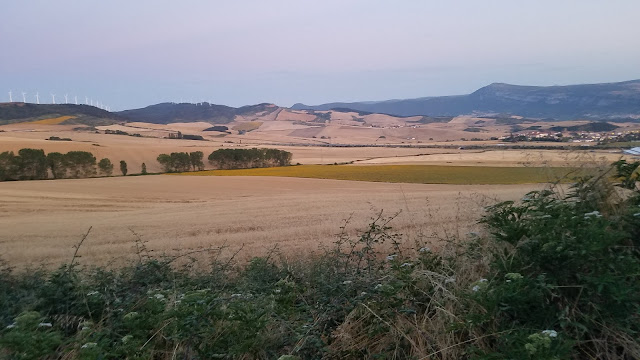The road to
Santiago de Compostela is ancient, going back over a thousand years. The original journey was not marked by signs
and books. The road connected the dots
between parish churches across Spain.
The road leads from church, to church, to church. Pilgrims learned “The Way” by listening to
church leaders along the path. They were
guided to the next destination, with local people providing food and
accommodation to the needy pilgrims.
Today, Spain
is facing a re-awakening in its economy.
Many areas are bleeding industries, and people are struggling to find a
meaningful living. After centuries of
helping pilgrims find The Way, the Camino has become a great economic engine
for these communities. There are
businesses selling food, accommodation, souvenirs, and other items throughout
The Way. It’s very helpful. They truly provide a service that’s needed
and appreciated by the pilgrims. What a
great pay-back for centuries of care for the travelers on this route!
We started
our day at 6:10 am, walking uphill to the windmills at the top of the ridge at
Alto de Pedron. Here, we find wind
turbines in the background, and the inscription “Where the way of the wind
crosses the way of the stars”. This
picture is from sunrise: super cold and windy.
Along the ridge lines are hundreds of wind turbines. They're a sight to behold!
Check out Paco's video of the turbines in action:
In theory,
The Way is labelled clearly with a specific Camino sign: a scallop shell, with
the large part of the scallop pointed in the direction of your
destination. Unfortunately, the artisans
who painted, tiled, cemented and otherwise marked The Way didn’t pay too much
attention to the direction of the scallops.
Sometimes they point in the right direction, and sometimes they were posted
backwards. So you can’t trust the
scallop sign, you have to look for the yellow painted arrow that identifies the
true direction. It can be really
confusing at times!
We walked
through many small towns along our way, one more beautiful than the next. We stopped for coffee at Puente La Reina, a medieval
town meaning “Queen’s Bridge” It was
erected in honor of Dona Mayor, wife of Sancho III, to help pilgrims make the
crossing of the River Argo at this important juncture.
You could see the wind turbines in the background for much of our path.
Much of our
trail was over old Roman roads. The
Romans built much of the infrastructure in this region: roads, towns,
fortifications, aqueducts. So going over
Roman roads sounds cool, right?
Not! It can be really rough on
your feet, as you can see below.
We hoped to reach a town called
Villatuerta. We couldn’t make it. Between the heat, the heights we needed to
reach, and our physical abilities, we stopped after 26 km. We had logged 10k steps by 7 am, and over 40k
steps for the day. We stopped in a small village called Lorca, and enjoyed a wonderful evening of fellowship with our fellow travelers.
Tommorrow
we’ll need to go further.






Hi Tina and Paco! I was so excited to hear you were on the Camino because my daughter, Sarita Madrid, is also there. Maybe you will run into each other as such amazing things happen on the Camino! Have a great time and enjoy every moment! Raelle Madrid- Virginia Beach
ReplyDelete